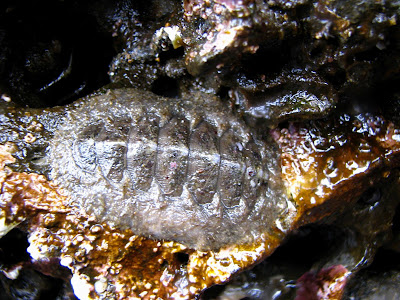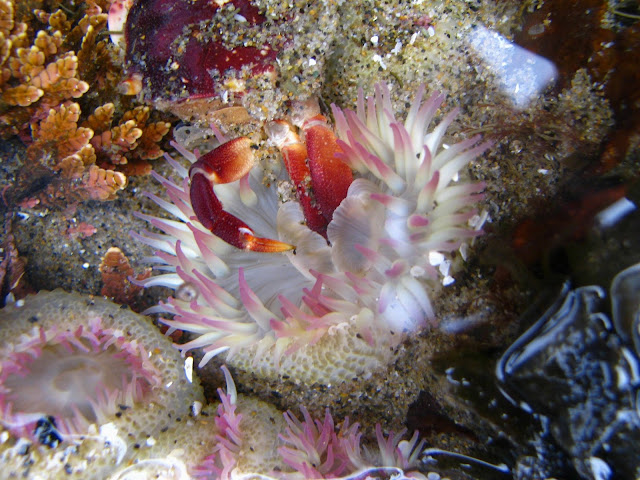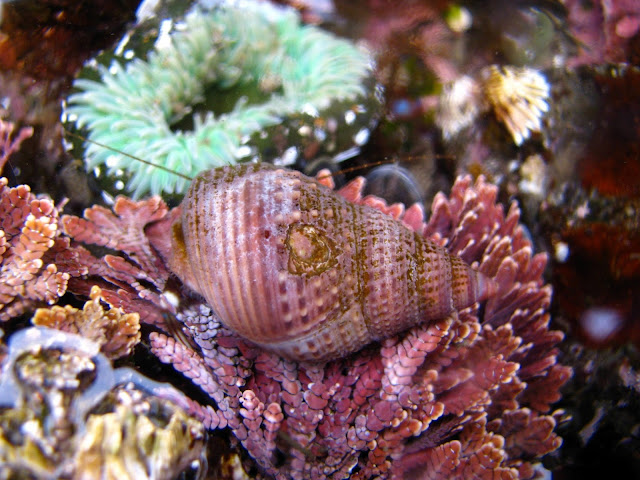 Considering my penchant for tide pools, and the fact that we didn't manage to see any Oregon tide pools on our road trip, its not surprising that the next expedition I undertook was to the coast. Cape Kiwanda is a state natural area, a designation I think was aimed partially at preserving the wildlife in the area. An old guy stopped to talk to me, and among the many things I learned is that you can only take one of these mussels (for bait) and other collection has been severely limited because (he didn't want to sound racist but) those Asians had been coming and picking things clean.
Considering my penchant for tide pools, and the fact that we didn't manage to see any Oregon tide pools on our road trip, its not surprising that the next expedition I undertook was to the coast. Cape Kiwanda is a state natural area, a designation I think was aimed partially at preserving the wildlife in the area. An old guy stopped to talk to me, and among the many things I learned is that you can only take one of these mussels (for bait) and other collection has been severely limited because (he didn't want to sound racist but) those Asians had been coming and picking things clean.  He then rhapsodized about the old days before there was a road and how there once was a honking buoy that you could navigate by until all those city folk moved out here and complained about it (as we all know, city folk are soft to the ways of nature and therefore cannot comprehend the use of a buoy that honks every time the waves swell) and how the old men used to drive their dories down to the beach to go out fishing and how you wouldn't go out on a day like this (the landscape being completely obscured by fog, this photo shows about an hour later when land forms began to resolve into real tangible objects) because there was no such thing as GPS... He and his wife run a nursery. He told me to watch Cannery Row because when he accosted me for his one sided conversation I was crouching quite gracefully (channeling my inner gazelle) over an anemone, camera in hand. Moving on.
He then rhapsodized about the old days before there was a road and how there once was a honking buoy that you could navigate by until all those city folk moved out here and complained about it (as we all know, city folk are soft to the ways of nature and therefore cannot comprehend the use of a buoy that honks every time the waves swell) and how the old men used to drive their dories down to the beach to go out fishing and how you wouldn't go out on a day like this (the landscape being completely obscured by fog, this photo shows about an hour later when land forms began to resolve into real tangible objects) because there was no such thing as GPS... He and his wife run a nursery. He told me to watch Cannery Row because when he accosted me for his one sided conversation I was crouching quite gracefully (channeling my inner gazelle) over an anemone, camera in hand. Moving on.
Some delectable sea lettuce and other sea 'plants' that I don't have a clue about. Despite my fascination I have yet to procure a basic guide for intertidal organisms.

Above are Acorn barnacles (order Sessilia). They are not stalked but probably derived from stalked barnacles and form monophyletic group (which stalked barnacles don't)
The left are Gooseneck/Leaf barnacles (Pollicipes polymerus) which are stalked and strangely intricate, as though someone took hours to fit all the little pieces together.
Anemones (in general) have stinging cells, called cnidocytes, in their tentacles which they use to stun their prey, although it is odd to think of typically sessile creatures as being predators. Prey in this case would be things like mussels, sea urchins, small fish and crabs.
Better yet...
There's a 'cardiotonic agent' present in green anemone tissues that has potential for treating failing hearts with advantages over current drugs. I said that poorly, you should look it up.
The best thing about these anemones (aside from their general spectacular-ness) is the nearly neon color at the base of their tentacles. The overall coloring might be contributed to by symbiotic (photosynthetic)algae and dinoflagelates. Maybe.
Aggregating anemone or Green Aggregating anemones (Anthopluera elegantis now sola) are pretty common, but that doesn't much detract from their coolness.Their color is also due in part to photosynthetic symbionts.

 They reproduce either sexually or asexually, and it is due to the latter that they form such dense colonies. Asexual reproduction in this anemone occurs via longitudinal fission... they split in half to form clones. Members of a colony are polymorphic (although genetically identical they express their genetics differently); individuals in the center of an aggregate reproduce sexually (no room to split) and individuals at the edge reproduce asexually.
They reproduce either sexually or asexually, and it is due to the latter that they form such dense colonies. Asexual reproduction in this anemone occurs via longitudinal fission... they split in half to form clones. Members of a colony are polymorphic (although genetically identical they express their genetics differently); individuals in the center of an aggregate reproduce sexually (no room to split) and individuals at the edge reproduce asexually.
When a colony edge encounters another colony... To war! they use their specialized nasty fighting tentacles to sting their opponents repeatedly to injure or even kill them. And thus lines between colonies are drawn. And they'll eat anything they can get their greedy little tentacles on.
In searching to identify this gray anemone I inadvertently discovered the answer to yesterday's trivia question... The flower in question is Anemone oregana, the Oregon or Blue anemone. Huh.But I didn't find what this is.
Obviously the tide pools weren't solely comprised of anemones and sea plants. There were a couple kinds of chitons... Chitons graze, scraping up algae, sponge and other little things
Black leather chiton (Katharina tunicata) has a 'skin' covering large portions of the plates on it's back and isn't sensitive to sunlight like most other chitons.

 I think this is a Mossy chiton (Mopalia muscosa), but I can't be sure.
I think this is a Mossy chiton (Mopalia muscosa), but I can't be sure.The picture below is a Lined chiton (Tonicella lineata). Because I am often over-prepared for life, you can see it is illuminated by my trusty flashlight... Apparently if it gets knocked off its perch it will curl up like a rolly polly (isopods). I read it, I didn't do it I promise. It might seem odd that its so colorful, but check out that encrusting sponge next to it... Blends right in. Its definitely the most aesthetically pleasing chiton I've seen to date.
There are always crabs. Even when you think you;re just taking a nice picture of a uniquely colorful shell. Suddenly you see antennae things poking out...
I'll admit, I fiddled with the one above, just a little bit. It was about this time that my camera rebelled against my continued accidental-partial-submersion in tide pool water and the inside of the lens started to fog. So from now on, if it seems extra hazy, that's why...
Crabs are harder to research because everything links you to crabbing so we'll just look at them and say "Awww what absurd looking little critters".

Some snails. I know exactly one species of snail (terrestrial or otherwise) and it is not either of these. But that little one has another snail or something clinging to it. Weird little world.
Here we have lots of Woolly sculpins (Clinocottus analis). Among other things I learned today... woolly sculpins are amphibious and will leave water if the oxygen level gets too low and can breathe air for 24 hours. As in... those silly evolution depictions of fishes finning their way out of the sea aren't completely bunk. Consider that for a moment. Also people tie flies to look like sculpins and so that is the predominate return on a Google search.
This may be my favorite picture of the day.
Some pink encrusting sponge saw fit to bedazzle this whole huge mussel. Above is an attempt to demonstrate the incredible diversity offered in an intertidal environment like this one. You could be staring for hours and still discover new things. Undoubtedly I missed many many many things in my couple hour survey.

 The birds of the day are the Black Turnstone (Arenanria melanocephala), the Pigeon Guillemot (Cepphus columba), and an unknown goose. I didn't get a particularly good look at the turnstones, they disappeared when the fog did.
The birds of the day are the Black Turnstone (Arenanria melanocephala), the Pigeon Guillemot (Cepphus columba), and an unknown goose. I didn't get a particularly good look at the turnstones, they disappeared when the fog did.  The geese... they flew over and then they were gone. But the Guillemots were loud and highly visible with their bright red legs, so they bore watching for a while.
The geese... they flew over and then they were gone. But the Guillemots were loud and highly visible with their bright red legs, so they bore watching for a while. Eventually that fog cleared out and revealed another huge rock out at sea. And what is it called? Haystack rock of course. Not to be confused with the Haystack at Cannon Beach, or the third one. Yup, three different features named the exact same thing. Not confuddling at all.
This haystack rock is 327 ft above sea level and is the 4th largest sea stack off shore in the World. The parks that make up the coast here are dunes. There is something inexplicably fascinating about dunes.
There are beautiful sandstone formations one the cape that demanded exploring.


I sat down for a while to eat and read and was gifted the entertainment of watching several of these guys try, and succeed, to fly.
Just some more great landscape... This is where I looked at intertidal organisms all morning. The rocks most worth investigating of course are now underwater. Some beach peas were just starting to bloom and the strawberries were going in full force. And that's that.
This is where I looked at intertidal organisms all morning. The rocks most worth investigating of course are now underwater. Some beach peas were just starting to bloom and the strawberries were going in full force. And that's that.I know this is a VERY long blog. If you made it this far, thanks for bearing with me. It took me like three hours to write and fiddle into being, so I hope you enjoyed all the sciencey factoids.
Here's another Lined Chiton as a reward, have a delightful Monday.































No comments:
Post a Comment
Note: Only a member of this blog may post a comment.